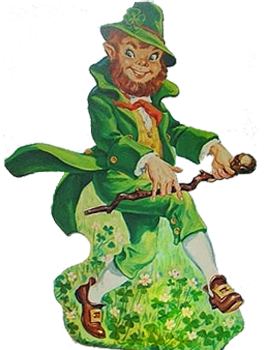
The Appearance of Leprechauns
-By Angelique Duncan
In March the Leprechauns begin to appear. They are often the ambassadors of Irish mythology and a modern symbol of St. Patrick’s Day celebrations. In early history they are described as short statured around three feet tall with red hair and often bearded, wearing red topcoats and always in a hat. Their coats were said to have rows of seven brass buttons. Their appearance was generally tidy and dapper with a stoic demeanor.
It is believed that the Leprechauns were the cobblers and bankers for the faeries and mystical folk. Legend has it that they would hold coins and shiny objects of value for the fairy clans in crocks that they would store in burrows and under mounds. To keep the wealth safe from humans, the Leprechauns were the only ones who knew where it was buried. They carry two pouches, one with silver coins that will magically reappear in the pouch once paid. In the other pouch they carry magical gold coins that they reserve for when they are in a tight spot and need to bribe or distract to get out of a situation. The gold coins are said to turn to ash once handed out and the Leprechaun has escaped out of sight.
In many legends the Leprechauns are deemed generally cranky, serious, hard working creatures, with strong ethics and are mostly solitary. Other than their shoemaking and bank dealings with the various faerie races, they prefer the company of other Leprechauns. They have earned the reputation of being miserly and tricksters. The reputation as mischievous tricksters is garnished by the great lengths and persistent measures they will go to evade humans.
Their aversion to humans stems from ancient history of Ireland, as it is believed that they were descended from the Tuatha de Danann. After being defeated in a series of power struggles, the Leprechauns, along with the other mystical tribes where driven under ground to live in caves and mounds. It is said that the Leprechauns were charged with the duty of protecting the riches of the ancients when they went into hiding.
A common theory is that later in history when Christianity took hold across Europe the followers of the ancient religions were eradicated and the remnants of the magical faeries and Leprechauns were driven further into hiding. Legends of the hidden treasures surfaced among humans and it was believed that if one could capture a Leprechaun, they could be forced to lead humans to the pots of hidden gold. It was thought that if one could follow a Leprechaun to the “end of a rainbow” the treasure would be found. It was once held that rainbows were markers to the buried ancient wealth and acted as portal openings to the enchanted underworld. To cross paths with a Leprechaun is said to be a rare occurrence and usually ends in frustration for the human who tries to capture and extract the location of the treasure from the Leprechaun.
The modern incarnation of Leprechauns are depicted as wearing all green, presumably to emphasize the wearing of the green and Irish pride for St Patrick’s Day. They are often described as unruly, prone to drunkenness, random mischief and vandalism. One explanation for the personality change in Leprechauns from their past reserved countenance is that what is being described in modern times is not actually Leprechauns, but Cluricans who are part of a different race that is related to Leprechauns. Although similar in physical appearance and possibly related to the Leprecaun, Cluricans are a separate race in the order of magical folk. Cluricans are noted for a love of harsh drink, rabble rousing and terrorizing livestock and crops to spite humans. They are said to be short in stature and untidy in appearance.
The practical explanation of the Leprechauns modern appearance and demeanor is that over time the folklore associated with the magical folk is mostly moot and forgotten. The modern Leprechaun that is associated with St. Patrick’s Day is an amalgamation of descriptions from fictional literature, film and early American stereotypes of the Irish.
St Patrick’s Day originated as a Christian holiday celebrating the victory of St. Patrick driving the “snakes” out of Ireland. The “snakes” are metaphorical for St. Patrick eradicating the non-Christians from Ireland. It was a celebration that the Pagan gods and myth had been muffled. Although regionally some do still celebrate March seventeenth as a holy religious day, in the modern United States it is marked as a day of Irish Pride for the obstacles overcome by immigrants in the new world. It is celebrated with merriment, wearing of green, exaggerated claims to Irish heritage, much drinking and the appearance of Leprechauns.
If there are still Leprechauns left in the world, they must get quite a chuckle at the irony that a holiday that once was created to celebrate their extinction, now celebrates their image as the quintessential Irish icon. Should you have the good fortune to glimpse a Leprechaun crossing your path raise a glass to honor him and his kind, he’s had a rough history and has managed to endure the test of time. Word of advice, don’t bother to try and follow him. He won’t tell you where the crock of gold is buried.
Angelique Duncan is proprietor of Twilight Faerie Nostalgic and Capricious Objects. Check out her artist page to find links to her shops and vintage inspired traditional holiday art. Visit again next month for more traditions and folklore.
